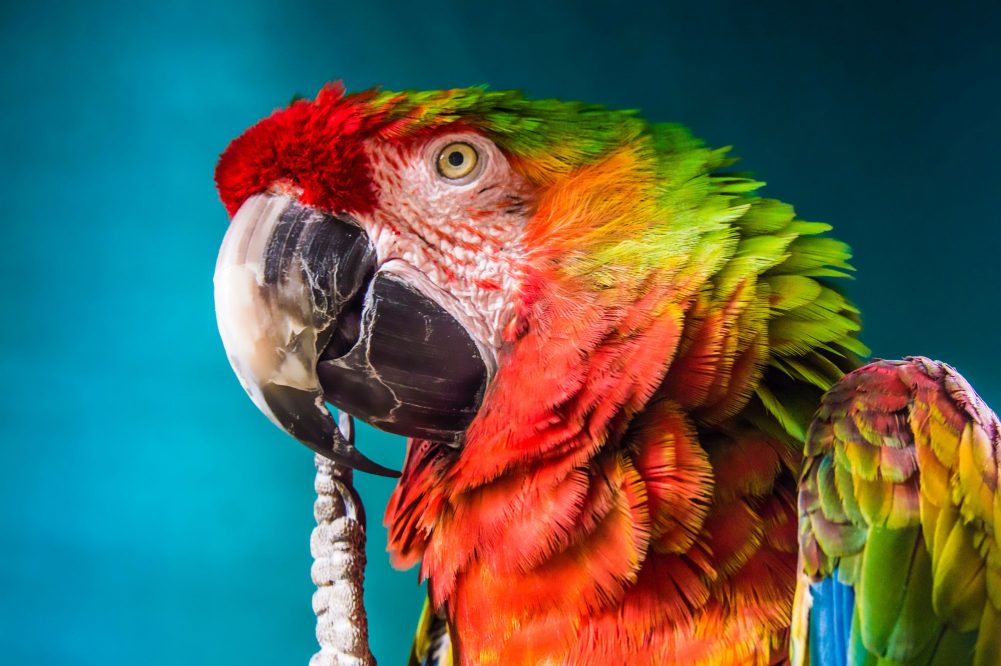This story is from the Jataka tales, stories of the Buddha’s past lives.
♦
The Buddha was once a little gray parrot.
When lightning sets a tree ablaze and her forest begins to burn, the parrot cries out a warning to others: “Fire! Run to the river!” Then she flies toward the safety of the river and its other shore.
But as she flies, she sees below her animals and trees already trapped, surrounded by flames. And suddenly she sees a way to save them. She flies to the river. The animals already huddled safely there are sure nothing more can be done. Each offers a valid reason for staying safely put and not making further efforts. But the little parrot says she has spotted a way, so she must try.
She wets her feathers in the river, fills a leaf cup with water, and flies back over the burning forest. Back and forth she flies carrying drops of water. Her feathers become charred, her claws crack, her eyes burn red as coals.
A god looking down sees her. Other gods laugh at her foolishness, but this god changes into a great eagle, flies down, and tells her, as it’s hopeless, to turn back. She won’t listen but continues bringing drops of water. Seeing her selfless bravery, the god is overwhelmed and begins to weep. His tears put out the fire and heal all the animals, plants, and trees. Falling on the little parrot, the tears cause her charred feathers to grow back red as fire, blue as a river, green as a forest, yellow as sunlight.
She is now a beautiful bird.
The parrot flies happily over the healed forest she has saved.
♦
The Brave Parrot Jataka tale embodies the central bodhisattva vow of Mahayana Buddhism—to free all sentient beings from suffering, which is caused by ignorance of True Nature. We also vow to release beings from the bondage we impose on them by our own inattention and ignorance—which also means we vow to liberate rivers, mountains, plants, oceans, animals, and fellow humans from the effects of exploitative social and economic systems.
Saving all beings is the first of the “Four Great Vows for All” known to all aspiring buddhas and bodhisattvas past, present, and future. The three remaining vows are actualizations of the first: to let go of our own habitual greed, anger, and ignorance; to recognize everything we encounter as a potential dharma gate opening into deeper understanding; and to undertake the task of embodying the ungraspable, selfless way of the Buddha. In other words, in order to fulfill the Great Vow to save all, we must do the hard—one might even say impossible—work of fully waking up.
The little parrot in this Jataka finds herself at a crossroads. She is capable of saving herself, but recognizes this is not enough.
At the beginning of the story the little parrot is content with her life. She has the gift of flight, after all. She is even happier at the end, having used her gift not just for her own sake but to liberate others. Her own great vow has become that much more real.
Greed, hatred, and ignorance arise in our minds, and if we build a self on them, we’re trapped. But if we don’t make our nest there, though self-centered thoughts come, they also go like the wind that shakes the branches and then disappears. We don’t fight them; we don’t try to stop them. We breathe into them, attend to our practice in the midst of them, and so see them arise and fade.
As we become freer of our own stuckness, we free others from what we ourselves no longer project onto them. To be free of ourselves is to free others from ourselves, from the burden of having to bear, and bear with, our needs, desires, and expectations. To free others is to diminish our fascination with the experience of isolated egotism.
This practice can and indeed must be taken up where we are, as we are; otherwise our vow remains just a distant ideal. This vow is not a formality, not simply something we recite after periods of zazen. Each day we do our best to dip in the river and fly back with a few drops of water for our burning world. Each day we practice the realization of this moment and engage this never-to-be-repeated moment of practice.
In koan number 14 of the Blue Cliff Record, a monk asks, “What is the teaching that Shakyamuni preached throughout his life?” Yun-men answers, “One preaching in response!” That’s it!
Philip Kapleau Roshi used to say that being a Buddhist doesn’t mean acting like Buddha, imitating the guy on the altar with the half-smile on his lips. If you’re at a party sitting in a corner with crossed legs, wearing a halo, looking wise and kind, Roshi might say, “Get up and dance! Try the hors d’oeuvres. Talk to people.” In short, respond to time, place, and circumstance. When sad things happen, we’re going to cry. When joyous things happen, we’ll laugh. When infuriating things happen, we might even get angry. “Selflessness” doesn’t mean we become like zombies or that we’re blown about by every wind. The dharma practice of releasing or seeing through self-centeredness leads to a fuller, more centered, and more fully present life.
From Before Buddha was Buddha, by Rafe Martin © 2018. Reprinted with permission of Wisdom Publications (wisdompubs.org).
Thank you for subscribing to Tricycle! As a nonprofit, we depend on readers like you to keep Buddhist teachings and practices widely available.
